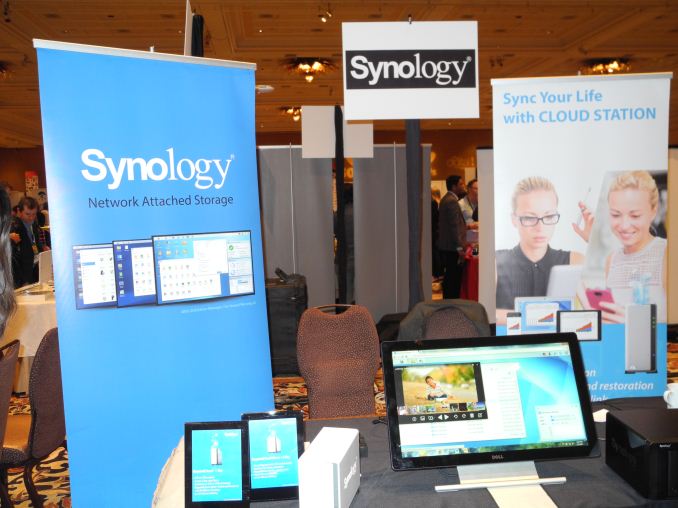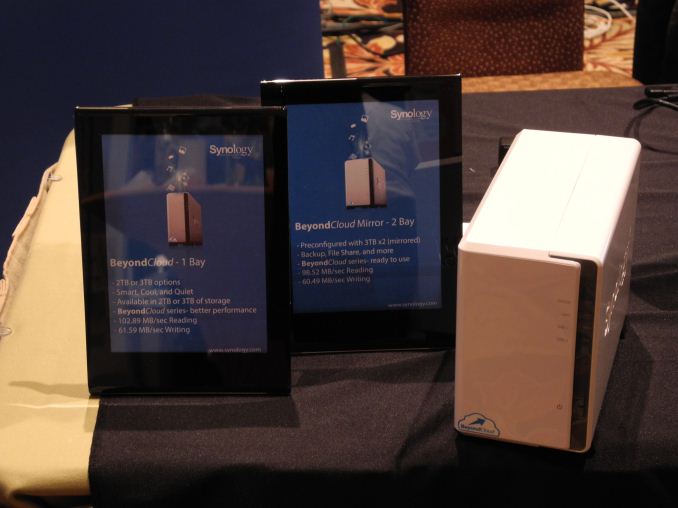Synology's BeyondCloud Series - NAS Units made User-Friendly
by Ganesh T S on January 6, 2015 10:30 AM EST- Posted in
- CES 2015
- Storage
- NAS
- Synology
- Trade Shows

Synology has put out some interesting updates (both expected as well as unexpected) in the lead up to the new year. At CES 2015, the focus is on a new series of NAS units to complement the traditional Disk Station (DS) lineup. The BeyondCloud (BC) package takes the traditional DS unit, preconfigures it with disks and sets up an appropriate volume. Certain packages (such as the multimedia-focused Photo Station and Video Station) are also pre-installed.
Newly purchased BeyondCloud NAS units are up and running immediately after purchase. As I have mentioned before in previous Synology reviews, setting up a JBOD or RAID-1 volume with fresh raw disks involves optimization of the configured file system. It often takes the better part of a day. The BeyondCloud series manages to hasten the setup process, and it is particularly useful for SMBs and busy tech-savvy users
On the other end of the spectrum, we have this new lineup making NAS units more friendly to the average consumer - those who are not comfortable with aspects such as shared folders and mapping network drives. In this area, I think Synology has a chance to jostle for space with the Western Digital EX2, Seagate Personal Cloud, LenovoEMC EZ Backup and Media Center and other such products which come with disks pre-installed and target home users. Given the ease of use of the DSM UI, home consumers should find the BC series a welcome competitor in this space.
The BC series currently has three members:
- BC115j 1200: 1-bay, 2TB hard disk pre-installed for $180
- BC115j 1300: 1-bay, 3TB hard disk pre-installed for $240
- BC214se 2300: 2-bay, 2x 3TB hard disks in RAID-1 for $370
The units are based on the DS115j and the DS214se. Both of them have a Marvell ARMADA 370 as the main SoC. The concept is great (albeit one that Western Digital and Seagate have already implemented in their consumer-focused personal cloud solutions). Synology can differentiate a bit by offering higher-end systems (4- and 5-bay ones) in a BeyondCloud configuration.
We met up with Synology at Pepcom, and they had the units on display, along with the SMB-focused DS2015xs and the DS414slim. On the CES show floor, they will also be having demonstrations of the new Surveillance Station (which doesn't require Java on the client systems anymore) as well as other features of the latest DSM.











12 Comments
View All Comments
MrSpadge - Tuesday, January 6, 2015 - link
I do not quite get it - what takes these personal cloud NAS units beyond the cloud?Mullasci - Tuesday, January 6, 2015 - link
Marketing.whats_in_a_name - Tuesday, January 6, 2015 - link
All the other good names are taken. Kinda like your choice of MrSpadge :)celestialbeing - Wednesday, January 7, 2015 - link
Is this a case of buying a NAS that comes with HDDs all pre-installed versus an empty box?jameskatt - Friday, January 9, 2015 - link
They are BEYOND THE CLOUD because you get to STORE YOUR CLOUD HARDWARE wherever you want yourself. You also get to manage the cloud yourself.vdidenko - Tuesday, January 6, 2015 - link
Synology's CloudStation client is very buggy after recent updates (mine routinely crashes and hogs resources, others' experiences are here: http://forum.synology.com/enu/viewforum.php?f=194, especially looks bad on the client side). The company's response seems to be absent or aloof, data access seems to be at random risk. With that the company can only rely on sales to technologically unaware consumers. Such sales are driven by buzzwords and glitz in marketing. Here you go.synology_usa - Monday, January 12, 2015 - link
Greetings vdidenkoThanks for your feedback; we would like to hear more about your input through our official communication channels found here
https://www.synology.com/en-us/company/contact_us
Thank you
Synology US Team
vol7ron - Tuesday, January 6, 2015 - link
I don't understand limiting bays to 1 or 2. Raid5 requires 3 bays, if it can't do that, then what's the point?vol7ron - Tuesday, January 6, 2015 - link
And what about low-powered Haswell?DanNeely - Wednesday, January 7, 2015 - link
Not everyone has a huge amount of data to store. A 3/4 drive configuration is more than most people who aren't either photography addicts or ripping large numbers of movie disks need. A 2 drive RAID1 (for fault tolerance) is suitable for their use and is smaller and cheaper as a result. The single drive models are going after people who're currently using a USB drive. Putting it on the network makes it more convenient to use; as do the built in media server applications. These are very much value NASes which is why they're using 1 or 2 3.5" drives instead of 2 or 4 2.5" ones; a Haswell CPU or even an Atom is ruled out for the same reason.